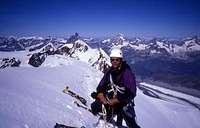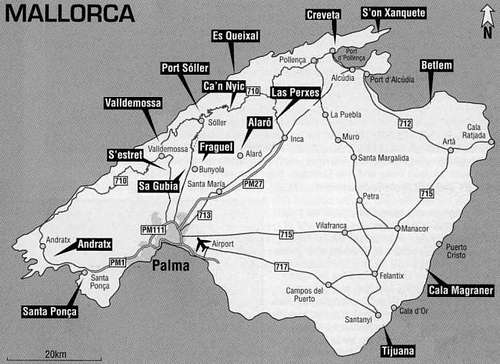-
 25619 Hits
25619 Hits
-
 81.84% Score
81.84% Score
-
 14 Votes
14 Votes
|
|
Area/Range |
|---|---|
|
|
39.78856°N / 2.79906°E |
|
|
Hiking, Sport Climbing, Bouldering |
|
|
Spring, Summer, Fall, Winter |
|
|
4740 ft / 1445 m |
|
|
In Memory of Stefan "kletterwebbi" Weber

A note from the SP staff Stefan Weber, the member we all used to know from his climbing pseudonym kletterwebbi, died on May 28th 2004 in southern France at the age of 37.
Stefan joined SP early on in 2002 and contributed a number of excellent pages and routes to this site. He was an accomplished climber excelling in difficult alpine and technical routes. The Dolomites, especially the area around Gröden / Val Gardena were special to him, as it was his old ancestral home.
kletterwebbi was always willing to share his knowledge and experience with other climbers, mainly here on SP, but also on other sites. He contributed his IT expertise as webmaster of his local section of the German Alpine Club, where he also engaged in leading trips for fellow members. Besides his climbing and mountaineering activities he was a musician, a composer of contemporary music. Stefan will be greatly missed by us all.
This page will be kept in honor of kletterwebbi, one of SP's most talented, knowledgeable members, and without a doubt, one of our greatest fellow mountaineers.
The picture was taken on the summit ridge of Lyskamm.
Overview
Yes, it's true, Mallorca isn't a mountain but Mallorca is an island. So why is there an island at this site ? There is one simple reason: Mallorca is an awesome place for climbing. There are about 16 main sectors and some other small areas with about 600 different modern sport climbs. Beside this there are some traditional lines at the higher mountains of mallorca. And even for hiking this island is worth more then one trip. This facts are well known by many european climbers, especially the british and german climbers try to escape their rainy weather at this island.Mallora is the biggest of the islands of the Islas Baleares, it's smaller sisters are Menorca and Ibiza. Both of them are offering good climbing possibilities too. Beside those three main islands there are other, smaller islands (Formentera, ...) part of the Islas Baleares. The capital of Mallorca is Palma de Mallorca and is situated at the SW coast. Palma de Mallorca has an international airport and is the center of the package holidays (especially the "El Arenal" area south of Palma de Mallorca). At the SE-coast and the NE-coast (around Alcudia) are many holiday appartments, visited by many families. In summer this are VERY crowded areas.
The highest point of Mallorca is the Puig Major (1445 m) at the northern part of Mallorca near the town of Soller. At the top of this mountain are some military installations. So the summit is closed. The highest reachable mountain is Massanella with 1.352 m.
The climbing areas are concentrated at the northern part of Mallorca in or near by the mountain range building up this beautiful part of the island. In the southern part are also some interesting seeside areas, especially the very popular crags of "Tijuana" and "Cala Magraner" can be found at the south coast.
Getting There And Around
Mallorca is famous for package holidays, so there are lots of flights to Palma from most european airports. It should be very easy to get a flight, and it should be easy too to get a cheap flight. From many of the German airports you can fly for less money, f.e. with Air Berlin, germanwings etc. At the island hiring a car is advised. The climbing crags are scattered all over the island. If you are planning to use the public transport without a car you'll need much time and some long walks to reach the crags. Cars can be hired at the airport at Palma. At high season it's better to hire a car from home to be shure to get one.Note: it's a good idea to avoid the hairpin-roads in the mountains if you want to go fastly to the crags. But it's a very good idea to use them if you want to have a scenic trip (very recommended).
Red Tape
There are some problems with the access to the crags. The situation is changing from time to time, but at some places uncooperative land owners have forbidden the access. So for the moment some great areas like the boulders of Bouquet, the walls of Calvía or the tufas of Ca'n Torrat are gone. Please be very careful with car parking, do not block roads, following the described paths of the guide books, also stay away from the banned crags. Don´t waste the ways to the rocks as many of them are private.When To Climb
Best time is spring and autumn, the temperature is pleasant and it's likely to be dry. Sometimes it can be stormy in autumn. Also winter is possible, many climbers take a trip at Christmas.Avoid the summer: In summer it is too hot for climbing and there are LOTS of people. Enjoy other climbing areas in Europe then.
Camping
At the Rock Fax guide book the situation is described as follows: "The most popular option for accomodation is to take advantage of the villas and apartments designed for the heavy Summer touristic trade ...". This is all to be sayed. Use the internet, go to a search engine like google, search for "Mallorca" and you'll find tons of possibilities. Or ask at a travel agency, they will offer many possibilities.There are three camping sites available in Mallorca. Camping outside of the authorized area is prohibited (remember the access problems, respect this prohibition). Here is a list of them:
Sun Club Picafort Open all year 1a-C, Ca'n Picafort Tel: 971 86 00 02 Fax: 971 71 78 96
Club San Pedro Open from may 15th to September 15th 1a-C, Colonia Sant Pere Tel: 971 58 90 23 Office: 971 73 03 65 Fax: 971 73 04 48
Lluc Monastery Lluc, Escorca Tel: 971 87 15 25
Mountain Conditions
Good source of informations are the common weather sites of the internet. Search for Spain and/or "Balearen". An german example: Wetter Online EuropaRoutes Overview
Mallorcas climbing areas are on limestone but Mallorca is famous for one special kind of climbing: tufas ! There are a lot of them, especially at the more difficult cliffs. Beside the tufas there are steep walls witch technical moves, overhangs, some slabs and a lot of undeveloped possibilities. All modern sport climbs of Mallorca are fully bolted with some excepts: the long, classical routes at Sa Gubbia need a small rack. Some bolts are somewhat rusty, especially at the sea cliffs. So take caution to that bolts. The local climbers are rebolting the routes actually (2003). To list all routes of Mallorca would exceed this page. Instead of this take a look at the following, brief overview of the crags of Mallorcas main crags (number of routes taken from the 2001-Rock Fax guide book):
- Andratx, 16 routes, best grades 6b to 7c, a small, new sector with massive potential for the future. - Santa Ponca, 7 routes, 7a and higher, a very small crag - S'Estret, 26 routes, best grades 4 to 5+ or 6b+ to 8a, three different sections - Valldemossa, 46 routes, best grades 5 to 7b, very popular area wit very easy access (streetside) - Sa Gubia, 93 routes, grades 3+ to 8a, the biggest area of Mallorca, routes for everyone, length between 30 and 200 m - Fraguel, 51 routes, best grades 5 to 8b, THE place for the hardmovers but also some very good easy climbs - Port Sollér, 25 routes, best grades 6a to 8a, beautiful landscape but somewhat rusty and only few routes - C'an Nyic, 11 routes, best grades 6a+ to 8a+, beautiful situated area at the mountains, few but good routes - Es Queixal, 13 routes, best grades 5 to 7a+, a long, tricky approach brings one to some very good climbs - Alaro, 45 routes, best grades 6a to 7c, an unbelievable rock, very dramatic setting. Bad to say, that there are some access problems with the land owners. - Las Prexes, 27 routes, best grades 7b to 8b+, two sections: one with hard (good !) and one with easy (not so good) routes - Creveta, 37 routes, best grades 4 to 7a, One of the best crags of the island. There are no "real" hard climbs but for the mid grades a very good area. - S'on Xanquete, 14 routes, best grades 7a to 8a, few, great routes of the steeper kind - Betlem, 20 routes, actually grades 5 to 7b+, Good mid grade climbs - Cala Magraner, 58 routes, grades 5 to 8a+, area by the sea with many routes, sometimes old gear - Tijuana, 35 routes, grades 4+ to 8a, superb sea cliff, very good, some old bolts
Some hints: - At (below) the sector S'Estret there is a very good bolder area. - Most times a single 60m rope will be fine, but 70 m might be a little more comfortable. - At Sa Gubbia the long, classical routes "Albahida", "La ley del deseo" and others need a 50 m twin rope if one want to abseil down. - Take care about the qualitiy of the bolts. Stay away from those rusty old plunder at some of the seeside cliffs.
Guidebook And Map
Guida de Escalada de Baleares by Lluis Vallcaneras (1996) Rock Climbs in Mallorca by Chris Craggs (2000) Rock Fax 13 Costa Blanca, Mallorca & El Chorro by Alan James and Mark Glaister, revision 2001, ISBN 1-87341-65-2When you are at the Mallorca climbing areas nearly everyone has the RockFax climbing guidebook. It intends all necessary informations, pictures and routes.
Firestone: Mapa turistico "Palma de Mallorca" T-26 or others
Climbing History
The climbing history of Mallorca starts late. The first routes where installed at the 1970's by a small group of spanish climbers. Members of this group where climbers such as Guillem Marti, Bernat Torres, Tolo Quetglas, Joan Riera, Juan Valiente or Adolfo Gregorio. In 1978 the Mallorcan climbing scene was "refreshed" by Jaume Payeras with partners like Miquel Riera. They started with free ascents even of the hardest routes - the modern sport climbing has reached Mallorca. Until the end of the 1980's the number of routes increased slowly. But then the drill had arrived and new routes where done all over the island. The difficulties of the routes where rising up to the 8c of today. About 1995 all slows down and only few new routes where created. The potential of Mallorca is gigantic: there are lots of all kinds of crags all over the island, waiting for new routes. At the moment it's just a beginning ...External Links
- Rockfax Homepage of the publishers of the Rock Fax guidebooks. With updates to the actual guidebooks.
- Trip report of a one week Mallorca trip in march 2003 (german language)
- Rocaroja Site with some informations about climbing in Mallorca.

















